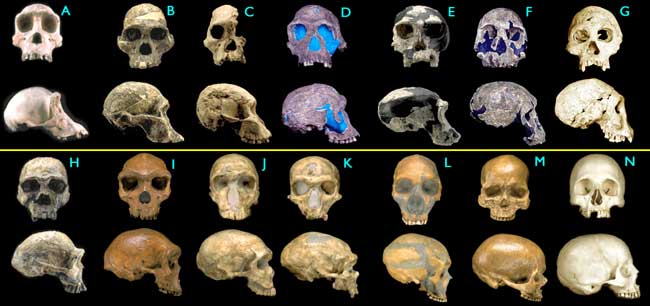
 |
Freethought & Rationalism ArchiveThe archives are read only. |
|
|
#861 | |
|
Veteran Member
Join Date: Jun 2000
Location: SC
Posts: 5,908
|
Quote:
|
|
|
|
|
|
#862 | |
|
Veteran Member
Join Date: Mar 2001
Location: Louisville, KY, USA
Posts: 1,840
|
Quote:
Patrick |
|
|
|
|
|
#863 | |
|
Veteran Member
Join Date: Mar 2001
Location: Louisville, KY, USA
Posts: 1,840
|
Quote:
You could argue that ER 1470 belongs to either Australopithicus or to Homo, because it has features of both. Amazingly, you seem to think that this somehow works in your favor, when in fact it is devastating to it. No matter how you wish to split or lump them taxonomically, there should be no doubt at all that ER 1805, ER 1813, and ER 1470 belonged to very closely-related homonids. Patrick |
|
|
|
|
|
#864 | |||
|
Veteran Member
Join Date: Mar 2001
Location: Louisville, KY, USA
Posts: 1,840
|
Quote:
For future reference, Archaeopteryx remains the oldest definite bird. You may have Sankar Chatterjee's Triassic Protoavis in mind. If so, then you need to understand that 1) it is far from clear whether this a bird at all (Sereno for example notes that Protoavis is "widely regarded as a composite of several nonavian species"), and 2) even if it is a bird, it is most certainly not a "modern bird," either in the sense of belonging to an extant genus or in the sense of being morphologically very similar to any living bird. Sereno, 1999. The evolution of dinosaurs. Science 284, 2137-2147. Quote:
Quote:
Patrick |
|||
|
|
|
|
#865 | |
|
Veteran Member
Join Date: Jun 2000
Location: SC
Posts: 5,908
|
Quote:
|
|
|
|
|
|
#866 | |
|
Veteran Member
Join Date: May 2002
Location: Just another hick from the sticks.
Posts: 1,108
|
Quote:
Further, if you'd given my post some thought, you'd see how, hypotheticaly, such a creature might have arisen. Yeesh! what a waste of time! :banghead: doov |
|
|
|
|
|
#867 | |||
|
Contributor
Join Date: Sep 2000
Location: Alibi: ego ipse hinc extermino
Posts: 12,591
|
Aha! Found it! I knew Ed had said something like this!
It was right back on 8 March 2002. Referring to the oft-posted picture (and, heehee, here it is again:  ... and asked which are human, and which ones ape, Ed said: Quote:
Okay... Quote:
Well, let�s put them side by side (or rather, one above the other  ) and compare. ) and compare.KNM-ER 1470:  KNM-ER 1813:  And let�s throw in OH24, while we�re at it: Quote:
Bearing in mind this greater variability, which you yourself claim... Bearing in mind, also, that by your own definition, a kind isn�t a species, but either a genus or even family... Are you honestly claiming these creatures could not be relatives? And don�t you bloody well dare, after all this time, to whiffle-waffle. Be specific. Millimetric specific. Or admit that they are the same kind. TTFN, Oolon |
|||
|
|
|
|
#868 | |
|
Veteran Member
Join Date: Mar 2001
Location: Louisville, KY, USA
Posts: 1,840
|
Quote:
Though I doubt you'll recognize it, you've pushed yourself into a corner. D and E in the image above, which you classify as human, are both habilis (RE 1813 and OH24, respectively). Now, if you don't mind lending us your expertise in vertebrate anatomy, please explain why in the world ER 1813 is human while ER 1805 is not. Patrick |
|
|
|
|
|
#869 | |
|
Contributor
Join Date: Sep 2000
Location: Alibi: ego ipse hinc extermino
Posts: 12,591
|
Quote:
[Ed mode] I have already said why. Dr Falk says the endocast is similar to that of an African pongid. Dr Falk says it's an ape. What more do you want? [/Ed]   Cheers, Oolon |
|
|
|
|
|
#870 | |||||||||||
|
Veteran Member
Join Date: Jun 2000
Location: SC
Posts: 5,908
|
Quote:
It doesnt, sometimes God wants us to use our brains. Quote:
Quote:
Quote:
Quote:
Quote:
Quote:
Quote:
Quote:
Quote:
Quote:
|
|||||||||||
|
|
| Thread Tools | Search this Thread |
|